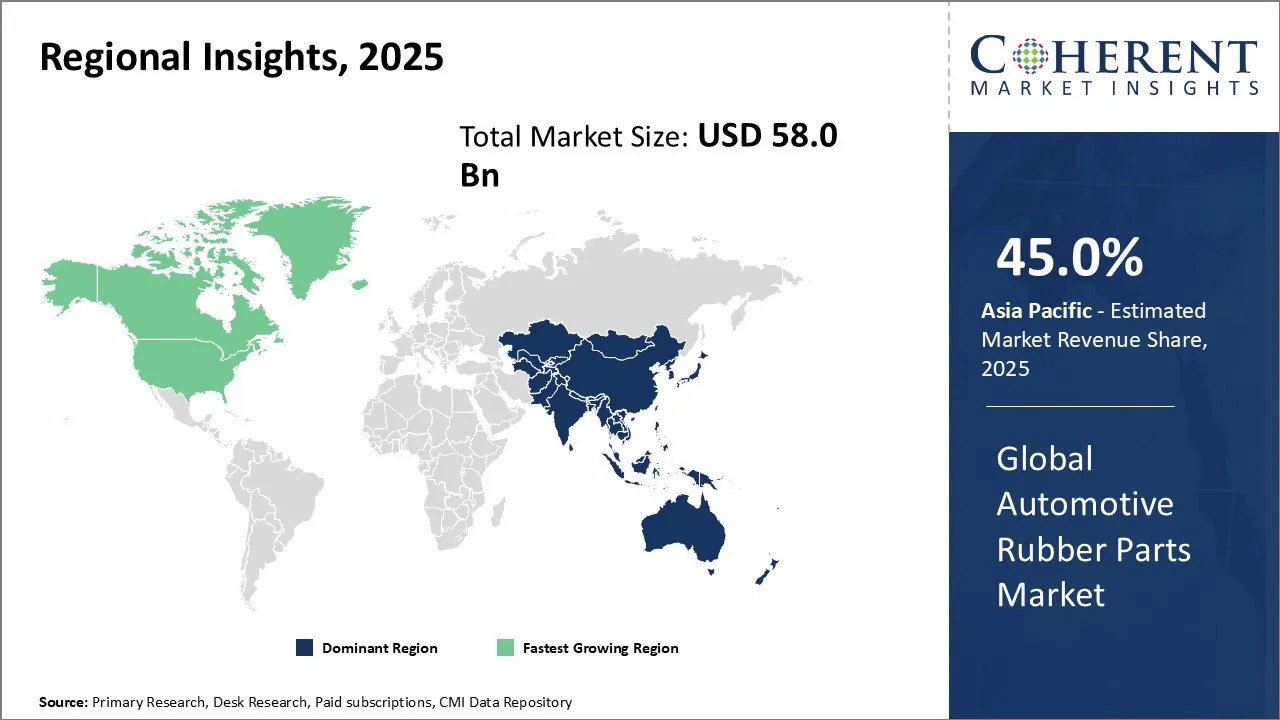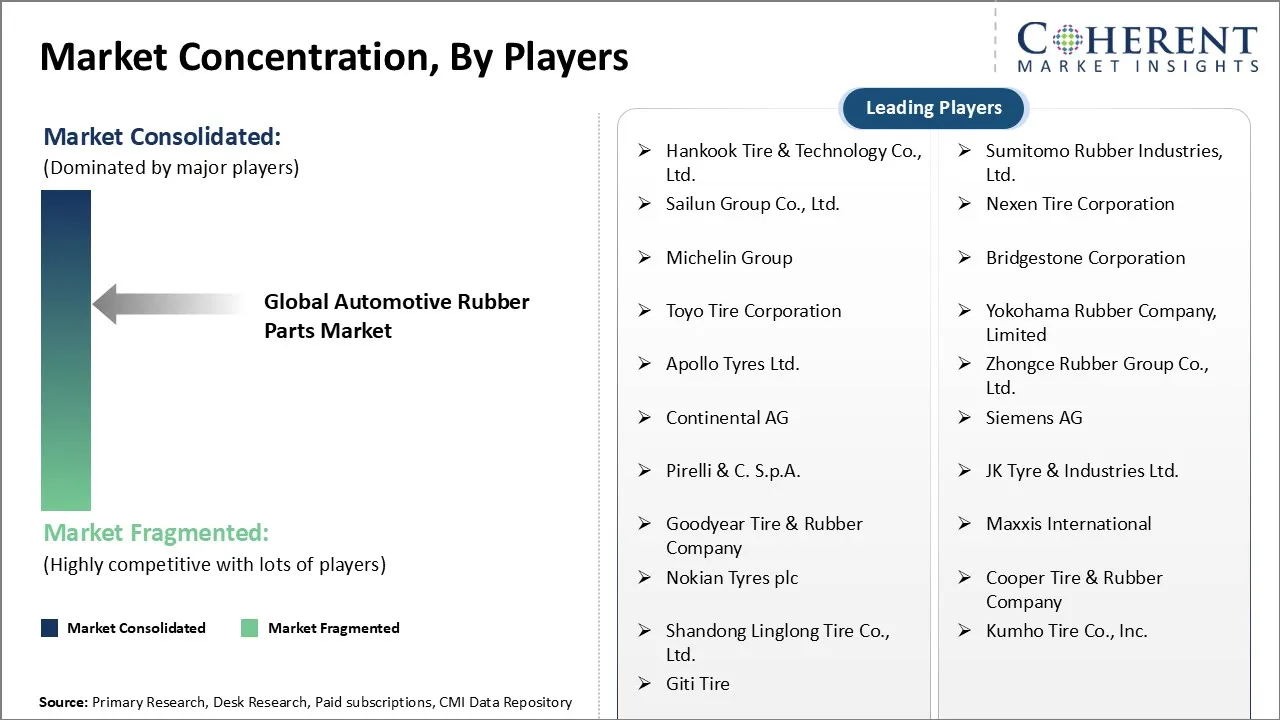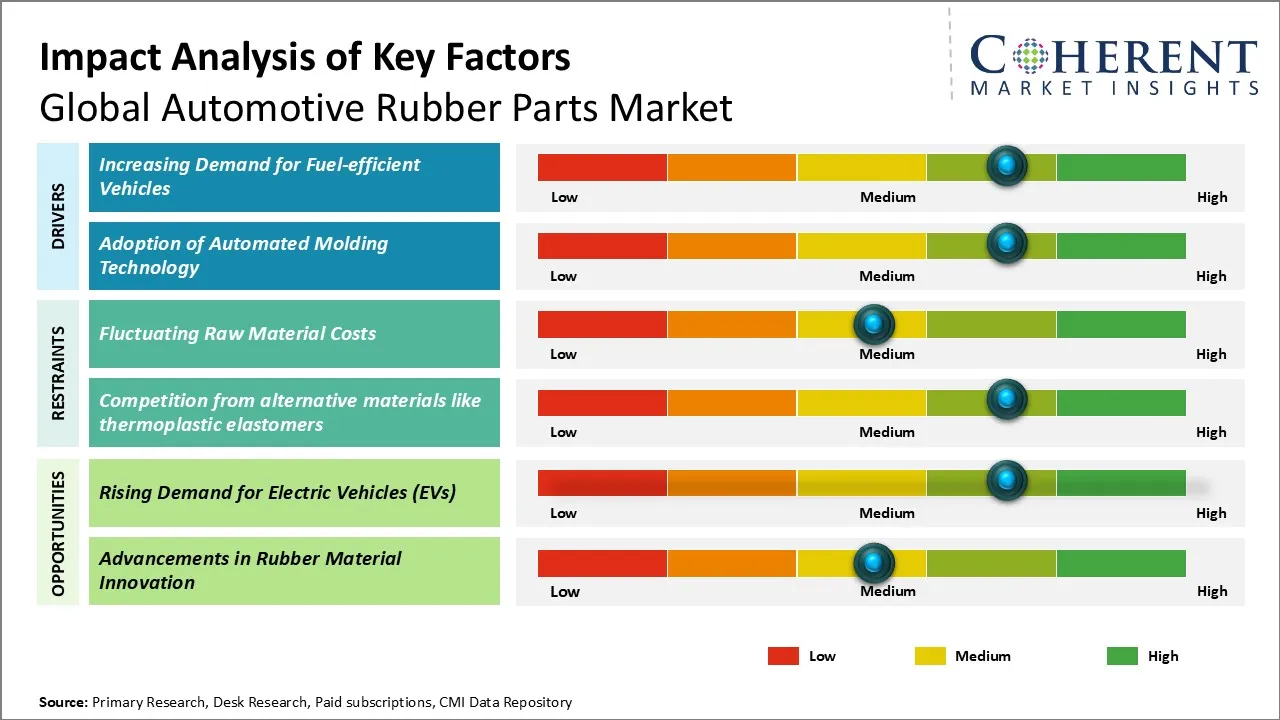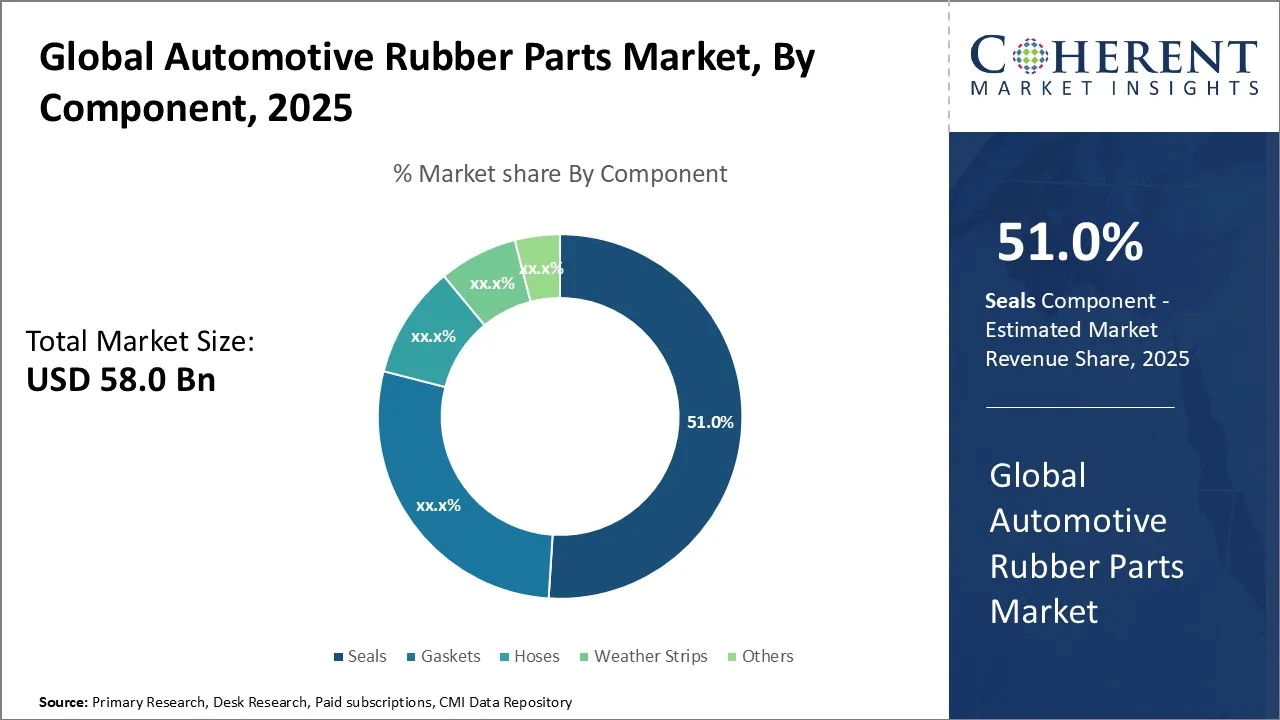Global Automotive Rubber Parts Market Size and Forecast – 2025-2032
The Global Automotive Rubber Parts market is estimated to be valued at USD 58 Billion in 2025 and is expected to reach USD 85 Billion by 2032, exhibiting a compound annual growth rate (CAGR) of 4.5% from 2025 to 2032.
Key Takeaways of the Global Automotive Rubber Parts Market:
- The seals segment is projected to capture 51% market share in 2025.
- Asia Pacific is expected to lead the global automotive rubber parts market with a 45% share in 2025.
- North America is projected to be the second-largest region with a 34% share for the automotive rubber parts market in 2025.
Market Overview:
The global automotive rubber parts market is spurred by the high demand for rubber components with a high endurance level and flexibility. Use of seals and hoses for vibration damping and harshness in extreme temperatures can augur favorably for the market. The development of novel rubber manufacturing technologies that gel comfortably with components used in hybrid and electric vehicles can further drive the market growth. However, fluctuating prices of raw materials due to geopolitical tensions and climatic changes can impede the market growth.
Current Events and Their Impact:
|
Current Events |
Description and its impact |
|
Launch of New Multi-segment Tires |
|
|
Expansion of Product Lines |
|
|
Divestment of Brands |
|
Uncover macros and micros vetted on 75+ parameters: Get instant access to report
Global Automotive Rubber Parts Market Insights, by Component: Seals to be Leading Segment in 2025 Owing to Stringent Emission Regulations
The seals segment is expected to capture 51% share of the market in 2025. This can be attributed to stringent emission regulation standards and the need of seals for preventing leakage in automotive systems. Sealing system manufacturers are patenting their designs to make automobiles lighter and safer. This is illustrated by Freudenberg Sealing Technologies in October 2024 and Cooper Standard in December 2024 patenting their sealing technologies respectively.
Global Automotive Rubber Parts Market Insights, by Material: EPDM to be the Biggest Segment in 2025 Owing to Broad Application in Automotive Systems
By material, ethylene propylene diene monomer (EPDM) leads the market with a 46% share in 2025 owing to its exceptional durability and broad applicability across automotive systems. Its molecular structure delivers outstanding resistance to extreme temperatures, operating reliably from -40°C to 150°C, making it indispensable for engine seals, radiator hoses, and exhaust components.
Global Automotive Rubber Parts Market Insights, by Vehicle Type: Passenger Vehicles to Dominate Due to Customer Expectations for Smooth Rides
By vehicle type, the passenger vehicles segment is expected to dominate over the forecast period in 2025 owing to customer expectations for smooth rides and cabin quietness. The demand for high-performance elastomers for optimal performance and isolation of vibrations can be a driving factor in this segment.
Role of Artificial Intelligence (AI) in the Automotive Rubber Parts Market
Transforming Rubber Manufacturing Through AI
The automotive rubber parts market is undergoing a significant transformation driven by artificial intelligence technologies. Manufacturers are integrating AI across their operations to enhance efficiency, quality control, and innovation capabilities. Silicone rubber manufacturing, a critical component of automotive parts production, has particularly benefited from AI optimization of production processes and material innovation.
A prime example of industry-wide AI adoption comes from Sumitomo Rubber Industries, a global leader in tire and rubber manufacturing. The company has strategically embraced data-driven solutions to enhance its manufacturing processes and improve product quality as part of its commitment to operational excellence. This shift represents how traditional rubber manufacturing is evolving to incorporate advanced technologies that drive competitiveness in the automotive supply chain.
Key Applications Driving Industry Innovation
The implementation of AI across the manufacture of rubber components spans several critical applications. Computer vision systems powered by AI now inspect welds, paint jobs, and assembly components with greater speed and accuracy than traditional manual inspections. These systems ensure consistent quality while reducing human error and inspection time.
Another significant application area is real-time production equipment guidance. AI algorithms help maintain close tolerances and high accuracy standards during manufacturing, crucial for automotive parts that must meet strict safety and performance requirements. Additionally, next-generation AI vision systems have revolutionized adhesive dispensing and welding applications in automotive assembly, enabling more precise application of rubber components.
Success Story: Sumitomo Rubber's AI Transformation
Sumitomo Rubber Industries exemplifies successful AI implementation in rubber manufacturing. The company transformed its core manufacturing process through Dataiku's automation platform, specifically optimizing the vulcanization process – a critical step in rubber production.
Prior to implementation, operators manually input production data and determined optimal manufacturing phases through time-consuming report analysis. This approach increased human error risks and made consistent quality difficult to maintain. After implementing AI-driven solutions, Sumitomo achieved remarkable results: 80% of product sizes showed enhanced consistency with the AI-optimized process, and the company saved significant operational hours through improved efficiency.
The system streamlined the entire production workflow by reducing manual data input and report generation, resulting in notable improvements in product quality. By February 2025, these changes had fundamentally enhanced Sumitomo's decision-making capabilities and manufacturing standards, demonstrating how AI can create measurable benefits in automotive rubber parts production while establishing new industry benchmarks for quality and efficiency.
Regional Insights:

To learn more about this report, Download Free Sample
Asia Pacific Automotive Rubber Parts Market Analysis and Trends
Asia Pacific is estimated to lead the global automotive rubber parts market with a 45% share in 2025. Improvements in traditional bush designs and leaps in material design can drive the market growth over the forecast period. The push for sustainable materials and influence of emission regulations for lightweight vehicles can bolster market growth. China, Japan, and India are expected to fuel the market demand over the forecast period.
North America Automotive Rubber Parts Market Analysis and Trends
North America is expected to hold a market share of 34% in the automotive rubber parts market in 2025. This can be attributed to the presence of major automakers and the large sales numbers from the region. The automotive aftermarket market that demands customized rubber components coupled with the increasing lifecycle of automobiles can influence the trajectory of the regional market growth.
The preference for larger vehicles like special utility vehicles (SUVs) can drive the demand for seals over the forecast period. Sealing solutions can withstand frequent pressures from engines. The shift towards electrification and the demand for tailored gaskets in electric motor assemblies can influence the growth of the overall automotive rubber parts market.
Automotive Rubber Parts Market Outlook for Key Countries
U.S. Automotive Rubber Parts Market Analysis and Trends
The U.S. accounts for the dominant share of the North America automotive rubber parts market. The presence of the aftermarket sector and the need for customized components can drive regional market growth. Rise of EVs and the demand for customized components can bolster market growth. Next-generation technologies in cars and the decision of component manufacturers to increase their production capacity can keep their revenues soaring. However, the tariffs by the U.S. government on imported components and materials can increase the prices of cars and act as a growth deterrent for the market.
China Automotive Rubber Parts Market Analysis and Trends
China automotive rubber parts market growth is driven by the expanding domestic transportation sector and customer penchant for comfortable cars. The integration of automation in manufacture of components as well as the presence of foreign automotive manufacturers establishing production sites can drive regional market growth. Additionally, adherence to the policies of EU Regulation on Registration, Evaluation, Licensing and Restriction of Chemicals (REACH) can bode well for the market.
Japan Automotive Rubber Parts Market Analysis and Trends
The Japan auto industry is settling in for a tough period owing to the impact of U.S. tariffs and the rising prices of rubber. Investments in research and development for the development of 3D-printed polymer composites can drive the regional rubber parts market. The soaring prices of rubber has led to automakers importing fully produced vehicles from its neighboring country like India. The expansion of the electric vehicle sector and investment to enhance production capacities can influence the market growth.
Canada Automotive Rubber Parts Market Analysis and Trends
Canada automotive rubber parts market is impacted by the increasing production of electric vehicles and the demand for seals and hoses. Emphasis on circular economy practices and the development of sustainable alternatives to rubber can fuel market growth.
Germany Automotive Rubber Parts Market Analysis and Trends
Germany's automotive manufacturing sector, led by companies like BMW, Mercedes-Benz, and Volkswagen, has demonstrated significant investment in high-performance sealing systems for their premium vehicle lines. The Continental AG's recent expansion of its sealing solutions division in Hannover reflects the growing demand for specialized automotive seals in hybrid and electric vehicle applications. In addition, a coalition agreement reached between the political parties in Germany for the abolishment of the reporting of compliance to the National Supply Chain Due Diligence Act (LkSG) in April 25, 2025.
Market Players, Key Development, and Competitive Intelligence:

To learn more about this report, Download Free Sample
Key Developments:
- On April 08, 2025, Continental AG, a major rubber parts and tire manufacturer, announced plans to separate ContiTech rubber and plastics division into a standalone entity. It can be listed by 2026.
- Toyoda Gosei, a leading manufacturer of rubber and metal automotive components, announced its plan to double its recycling capacity of rubber in Japan on October 18, 2024.
- On January 09, 2025, American Axle & Manufacturing (AAM) announced the acquisition of the Dowlais Group plc. This expands their portfolio of AAM by integrating the production of internal combustion engines (ICE).
- Freudenberg Sealing Solutions, a leading producer of high-performance seals from Germany, has patented 2 seal designs, a cassette seal and V-seal, for in-wheel motors within electric vehicles on October 24, 2024.
Top Strategies Followed by Global Automotive Rubber Parts Market Players
- Established Players: Expansions and Mergers - Key vendors in the automotive rubber parts market are increasing their production capacity by establishing rubber facilities overseas. The inflated prices of rubber and alternative sources for rubber are driving the trend.
- For instance, Freudenberg Sealing Technologies opened a new plant in Spain on February 19, 2024. It launched a carbon-neutral plant by adhering to new laws for reducing carbon footprints globally through sustainable manufacturing practices.
- Mid-Level Players: R&D Solutions - Medium -sized players are creating green alternatives for rubber grades like EPDM and SBR. The materials can be used in the production of automotive components such as seals and interior components.
- Chi Mei Corporation, a Taiwanese company, developed an eco-friendly plastic, BIO ABS, in 2023. It was used in the production of customized hoses and seals.
- Small-Scale Players: Specialization in Customized Components - Small-scale manufacturers are engaged in producing tailored components for large automotive manufacturers.
- For instance, on June 17, Tosoh Corporation announced its plans to increase its production capacity of Skyprene chloroprene rubber. It has applications in automotive hoses and belts.
Market Report Scope
Automotive Rubber Parts Market Report Coverage
| Report Coverage | Details | ||
|---|---|---|---|
| Base Year: | 2024 | Market Size in 2025: | USD 58 Bn |
| Historical Data for: | 2020 To 2024 | Forecast Period: | 2025 To 2032 |
| Forecast Period 2025 to 2032 CAGR: | 4.5% | 2032 Value Projection: | USD 85 Bn |
| Geographies covered: |
|
||
| Segments covered: |
|
||
| Companies covered: |
Sailun Group Co., Ltd., Apollo Tyres Ltd., Bridgestone Corporation, Yokohama Rubber Company, Limited, Sumitomo Rubber Industries, Ltd., JK Tyre & Industries Ltd., Hankook Tire & Technology Co., Ltd., Michelin Group, Nexen Tire Corporation, Continental AG, Pirelli & C. S.p.A., Kumho Tire Co., Inc., Giti Tire, Nokian Tyres plc, Zhongce Rubber Group Co., Ltd., Cooper Tire & Rubber Company, Shandong Linglong Tire Co., Ltd., Toyo Tire Corporation, Goodyear Tire & Rubber Company, and Maxxis International |
||
| Growth Drivers: |
|
||
| Restraints & Challenges: |
|
||
Uncover macros and micros vetted on 75+ parameters: Get instant access to report
Market Dynamics

To learn more about this report, Download Free Sample
Global Automotive Rubber Parts Market Driver – Increasing Demand of Fuel-efficient Vehicles
The increasing demand for fuel-efficient vehicles, particularly the launch of electric and hybrid vehicles, can drive the growth of the automotive rubber parts market. The demand in developing countries has induced the requirement for customized rubber components to ensure a smooth driving experience.
Global Automotive Rubber Parts Market Opportunity – Rising Demand of EVs
The high sales numbers for electric vehicles (EVs) have created the need for rubber components. The policy shifts by various nations towards EVs and intentions to curb pollution levels can augur favorably for the global market. The integration of EPDM, silicone rubber, and high consistency rubber (HCR) as sealing materials in cooling systems is a clear indicator of the high demand for rubber molded parts.
Analyst Opinion (Expert Opinion)
- The automotive rubber parts market is experiencing steady growth driven primarily by the expanding global automotive industry. Growing consumer demands for enhanced comfort, safety, and noise reduction within vehicles have increased the necessity for high-quality rubber components. Furthermore, stringent governmental regulations aimed at reducing emissions have influenced manufacturers to opt for advanced rubber solutions that increase fuel efficiency and decrease overall vehicle weight.
- However, market expansion may encounter certain restraints, such as fluctuations in raw material pricing and a continuous emphasis on sustainability. Increasing prices of natural rubber and environmental concerns impact profit margins, pushing market participants to innovate cost-effective production methods and recyclable alternatives. Additionally, rising adoption of electric vehicles poses unique challenges, as electrification significantly alters traditional automotive rubber components.
- The Asia Pacific region currently dominates the automotive rubber parts market, primarily fueled by extensive manufacturing capabilities and robust automotive production hubs in countries such as China, India, and Japan. The region's market has significantly benefited from favorable government policies, low labor costs, and the rising prices of rubber. Meanwhile, North America and Europe remain strategically important due to their ongoing shift towards high-quality, lightweight rubber components focused on performance enhancement in luxury and electric vehicle segments.
- As automotive innovation accelerates, there lie immense opportunities for market players emphasizing sustainable, eco-friendly rubber solutions. Collaboration of rubber component manufacturers with automotive OEMs in technology-driven R&D is essential to cater effectively to rapidly evolving industry standards and consumer preferences.
Market Segmentation
- Component Insights (Revenue, USD Bn, 2020 - 2032)
-
- Seals
- Gaskets
- Hoses
- Weather Strips
- Others
- Material Insights (Revenue, USD Bn, 2020 - 2032)
-
- Ethylene Propylene Diene Monomer (EPDM)
- Natural Rubber (NR)
- Styrene-butadiene Rubber (SBR)
- Others
- Vehicle Type Insights (Revenue, USD Bn, 2020 - 2032)
-
- Passenger Vehicles
- Commercial Vehicles
- Regional Insights (Revenue, USD Bn, 2020 - 2032)
-
- North America
- U.S.
- Canada
- Latin America
- Brazil
- Argentina
- Mexico
- Rest of Latin America
- Europe
- Germany
- U.K.
- Spain
- France
- Italy
- Russia
- Rest of Europe
- Asia Pacific
- China
- India
- Japan
- Australia
- South Korea
- ASEAN
- Rest of Asia Pacific
- Middle East
- GCC Countries
- Israel
- Rest of Middle East
- Africa
- South Africa
- North Africa
- Central Africa
- North America
- Key Players Insights
- Sailun Group Co., Ltd.
- Apollo Tyres Ltd.
- Bridgestone Corporation
- Yokohama Rubber Company, Limited
- Sumitomo Rubber Industries, Ltd.
- JK Tyre & Industries Ltd.
- Hankook Tire & Technology Co., Ltd.
- Michelin Group
- Nexen Tire Corporation
- Continental AG
- Pirelli & C. S.p.A.
- Kumho Tire Co., Inc.
- Giti Tire
- Nokian Tyres plc
- Zhongce Rubber Group Co., Ltd.
- Cooper Tire & Rubber Company
- Shandong Linglong Tire Co., Ltd.
- Toyo Tire Corporation
- Goodyear Tire & Rubber Company
- Maxxis International
Sources:
Databases
- Factiva
- Bloomberg Terminal
- Others
Magazines
- Automotive News
- Rubber World
- European Rubber Journal
- Plastics & Rubber Weekly
- Others
Journals:
- Journal of Applied Polymer Science
- Rubber Chemistry and Technology
- International Journal of Automotive Technology
- Others
Newspapers:
- The Wall Street Journal (Automotive Section)
- Financial Times (Industry News)
- Automotive News Europe
- Nikkei Asia
- Others
Associations:
- International Rubber Study Group (IRSG)
- Society of Automotive Engineers (SAE)
- Rubber Manufacturers Association (RMA)
- European Tyre and Rubber Manufacturers' Association (ETRMA)
- Others
Public Domain Sources:
- U.S. Department of Transportation (DOT) reports
- European Environment Agency (EEA) publications
- National Highway Traffic Safety Administration (NHTSA) data
- World Bank industry statistics
- Others
Proprietary Elements:
- CMI Data Analytics Tool
- Proprietary CMI Existing Repository of Information for Last 8 Years
Share
Share
About Author
Gautam Mahajan is a Research Consultant with 5+ years of experience in market research and consulting. He excels in analyzing market engineering, market trends, competitive landscapes, and technological developments. He specializes in both primary and secondary research, as well as strategic consulting across diverse sectors.
Missing comfort of reading report in your local language? Find your preferred language :
Transform your Strategy with Exclusive Trending Reports :
Frequently Asked Questions
EXISTING CLIENTELE
Joining thousands of companies around the world committed to making the Excellent Business Solutions.
View All Our Clients


